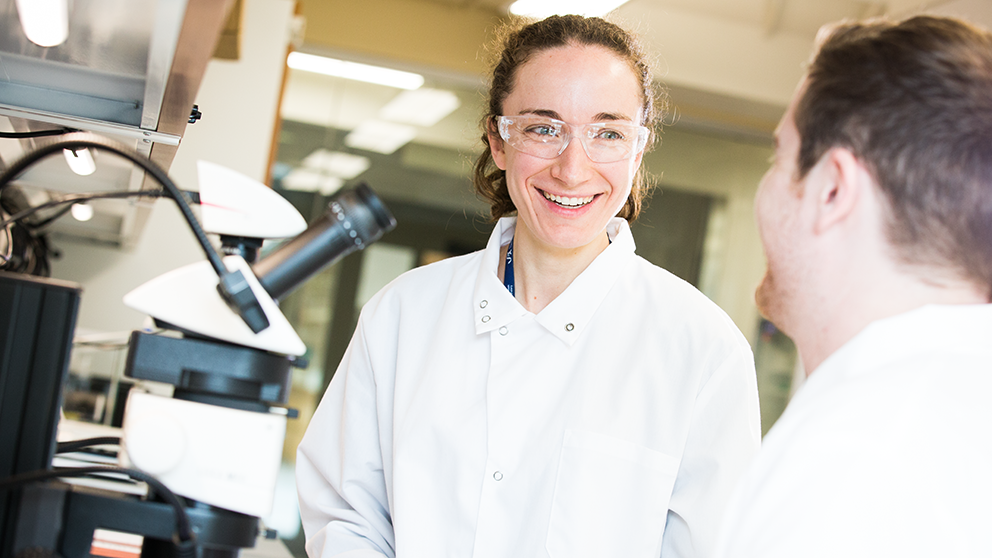 The Jackson Laboratory's Beth Dumont in her lab. Photo credit: Tiffany Laufer
The Jackson Laboratory's Beth Dumont in her lab. Photo credit: Tiffany Laufer
It was the summer of 2002. “Hot in Herre” by Nelly topped the music charts. The Boston Red Sox were toiling through year 84 of the Curse of the Bambino. And, for the 78th year, students gathered in Bar Harbor, Maine, for an immersive research experience. It was an intense experience for all, but, for some, it would be life-changing.
Among those who traveled to The Jackson Laboratory (JAX) campus in Bar Harbor for the renowned Summer Student Program (SSP) that year was Beth Dumont, a rising sophomore at Cornell University. A native of Augusta, Maine, she had wanted to spend the summer closer to her family. She came across the SSP somewhat by accident, but, as a biology major, it seemed like an interesting way to return to her home state for the summer.
“I’d heard of JAX but only as a mouse supplier, so I had no idea what I was getting myself into,” says Dumont. “I didn’t know about research outside of basic freshman biology and chemistry labs. But it was awesome.”
Fast forward more than two decades, and Dumont is an associate professor on the JAX faculty, a leader in the field of population genetics and a mentor for students each summer. Her experience bridges JAX’s past and present and highlights what makes it so unique and so important in the research world.
The wonders of variation
Dumont spent her summer in the laboratory of Beverly Paigen, whose research program covered wide-ranging interests. When she first arrived, she had no experience with even the most basic lab techniques, including how to pipette. Paigen assigned Dumont a postdoctoral associate to supervise her directly, but he was at a conference when she first stepped into the lab. In stepped another postdoc, Ron Korstanje, to get her off to a good start. As fate would have it, Korstanje would also subsequently join the JAX faculty and work with Dumont as a colleague. And to truly bring things full circle, Maike Korstanje, Ron’s daughter, recently completed an academic year internship in the Dumont lab.
Although she didn’t know it at the time, Korstanje’s guidance helped launch Dumont on a project that would shape her future training and career. Her work that summer contributed to a project that aimed to identify genomic regions contributing to differences in susceptibility to cholesterol gallstone disease between mouse strains. Mapping studies in the early 2000s rarely succeeded in identifying single genes contributing to disease, but rather localized genetic effects on a trait of interest to broad regions of the genome — termed loci — containing multiple genes. Dumont’s effort focused on identifying compelling candidate genes within these mapped loci using the nascent mouse genome sequence and testing candidate genes for sequence and expression differences between strains.
“With the project, I grew to appreciate the ways we can leverage the differences between mouse strains to pinpoint the genetics that underlie disease susceptibilities,” says Dumont. “But this led to other questions: How and why do the differences arise in the first place? And what roles do they play in function and biology?”
The fundamentals
The answers to those questions lie in the field of population genetics, which Dumont characterizes as the study of where genetic variation comes from and why it exists in the patterns that it does through time and space. In humans, it’s vital for studying how population differences contribute to variable disease susceptibility and risk. Dumont returned to Cornell enthusiastic and motivated to pursue this new-to-her research area, and she reached out to faculty working in the field. One needed help, and he subsequently hired her to work in his lab as an undergraduate. Fortuitously, Dumont had connected with Andy Clark, someone who was not exactly a typical professor and also had ties with JAX.

“Andy had been involved with the Human Genome Project and literally wrote the book on population genetics, and I’m glad I didn’t know beforehand that he was such a bigshot in the field!” says Dumont. “He was also a regular instructor at the McKusick Short Course, so he knew JAX as well. I worked with him throughout my remaining time at Cornell.”
Working with Clark provided a further boost to Dumont’s studies when she went to graduate school and did her thesis work with a former postdoc of Clark’s at the University of Wisconsin-Madison. There she focused on the genetic control of recombination rates. Recombination is a fundamental but somewhat counterintuitive biological mechanism, in that it involves breaking the genome in many places and then repairing the breaks, resulting in a scrambling of genetic traits for the next generation. It is a necessary step at the onset of meiosis, in which mature gametes (eggs or sperm) are produced, each ultimately containing only one set of chromosomes rather than the two present in other cells.
Evolution in the lab
Ph.D. in hand, Dumont went on to postdoctoral appointments at the University of Washington and then North Carolina State University (NCSU). At NCSU she was awarded a federal grant, called a K99, to enhance her independent research. Her work expanded her exploration of recombination biology, honing in on sex chromosomes and the regions on them essential for recombination and proper segregation during meiosis. It also provided her with the experience she needed for her next step forward: starting her own independent laboratory. And in 2016, she returned to JAX to do just that.
Now Dumont works with a unique resource at JAX: diverse mouse populations. Her work still investigates recombination and other biological mechanisms, but she is now seeking to answer even larger questions: How do species originate and evolve? The genetically diverse mice provide her with essential insights.
“I’m thrilled to be at JAX, because many of the projects using genetically diverse mice are basically beautifully curated evolutionary experiments in action,” says Dumont. “I can track the process of DNA transmission from one generation to the next because we know how the DNA segregates between generations. We can learn how many mutations accumulate, how and where they accumulate … it’s evolution in a self-contained environment.”
She also gives back, seeking to work with students each summer who may not have previously thought about research as a career, like her when she first arrived at JAX.
“It’s wonderful to be on the other side and to be able to nurture the potential in students over the course of the 10-week program,” she says. “I also keep in touch with (now) colleagues who went through the program and follow their research trajectories. For many, like me, it was a transformative experience and provided opportunities that they otherwise wouldn’t have had.”